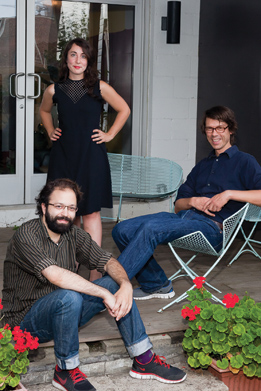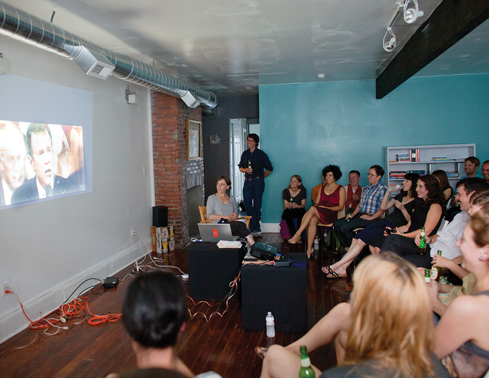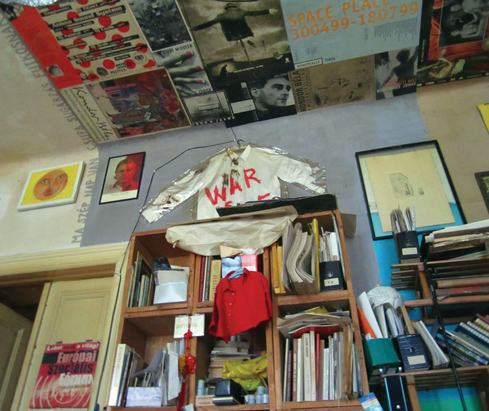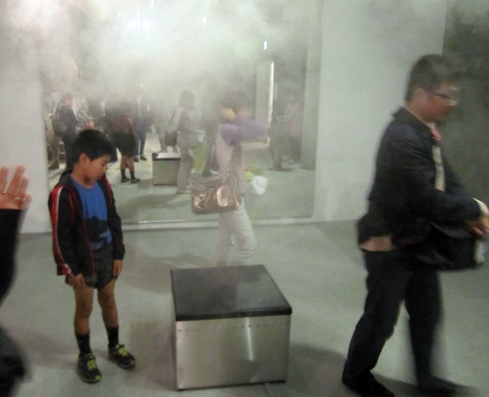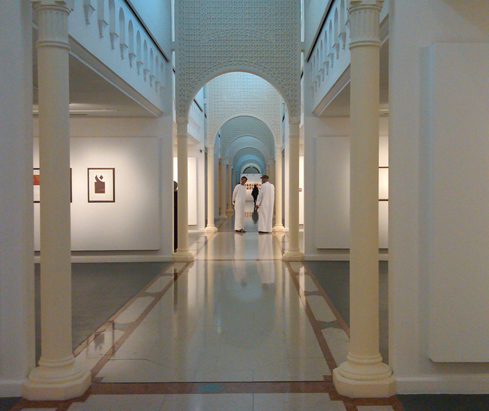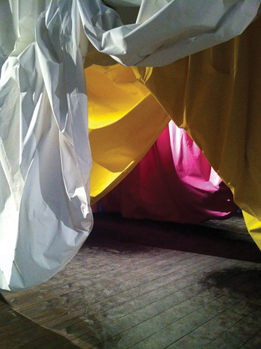 |
||||||||||||||||
|
In October, Daniel Bauman, Dan Byers, and Tina Kukielski spent a whirlwind week in London. |
Above: Photos by Justin HopperInternational Negotiations The next Carnegie International is unfolding as a conversation-among its curators, its home city of Pittsburgh, and artists from around the globe.
It’s October 13 near London’s famed Piccadilly Circus, and Daniel Baumann, Dan Byers, and Tina Kukielski, the three joint-curators of the 2013 Carnegie International, stand in the prestigious Hauser & Wirth Gallery. Its main room is full—not of visitors, though there are many of those, but of imposing figures: dozens of two-story-tall sculptures made of found wood and plaster that British artist Phyllida Barlow has constructed to all-but-fill the space. “For years she was kind of unknown,” Baumann says of Barlow. “But she’s taught many of the most famous of today’s British artists—Rachel Whiteread, Tacita Dean. Only recently has there been a revival of interest in her work.” The trio of curators lean in, ears cocked, as the artist herself describes the concept of her current exhibition, RIG. “My relationship with sculpture is very much architectural,” says Barlow, simplifying her complex work like a true teacher. “The narrative is one of negotiation of space. So, in a way, this whole show is asking, ‘How is the work circumnavigated by the audience?’” The three curators are obviously impressed, and reasonably so. Barlow’s work is awe-inspiring in its scope and strange beauty. But for Baumann, Byers, and Kukielski, there’s another interest at play. It’s exactly these kind of negotiations—of physical and personal space, but also of institutional concepts and of the realities of living in a specific city but with a global worldview—that are consuming their minds as they build the latest in the century-old tradition of the Carnegie International.
The 2013 Carnegie International will be the 56th edition, making Carnegie Museum of Art’s famed survey the oldest contemporary art exhibition in America. But in an ever-shifting world in which a balance between globalized ubiquity and localized specificity becomes more important than ever, the museum has decided to expand on or redefine its mandate to discover “the old masters of tomorrow.” That’s why, like many of their predecessors, the three curators are spending half their lives going up and down in airplanes, visiting artists in many countries including Poland, Brazil, and Japan, and attending events such as the Frieze Art Fair, which brings them to London this particular week. But only a month earlier, they were breakfasting around a cafeteria-style table in the Elks Lodge in Braddock, Pa.
There, Mayor John Fetterman, well-known in Pittsburgh and around the country for his efforts to revitalize that troubled former steel mill town, explains to the curators that, as they’d suspected, Braddock has spaces perfect for artists with an interest in raw physical space and historical texture. “I can guarantee that we’ll have space available for you, and that it’ll be interesting,” Fetterman tells them.
Revising history “We have a good feel for the tone and the feel of what this exhibition’s going to be like,” Byers explains post-meeting. “For example, here, our question isn’t ‘What can we do in Braddock?’ but has to be, ‘How does the Carnegie International insert itself into Braddock—How does it make that relationship a conscious decision, and create a situation that produces something energetic and generous?’”
Sitting in the Braddock club, the curators jokingly call Lynn Zelevansky, The Henry J. Heinz II Director of Carnegie Museum of Art, the exhibition’s “meta-curator,” for she selected them as its curatorial team. Historically, it’s been built by a single individual, except for four exhibitions led by pairs of curators. “I wanted this International to involve a conversation rather than a lecture,” says Zelevansky. “It seems to suit our times better.” That conversation, in Zelevansky’s view, is between “the global and the local”—between an increasingly connected world and the artists interpreting it, and a very specific vision of the role that Pittsburgh and Carnegie Museum of Art can play in that world. According to Zelevansky, it’s not only a concept for the International, but an important revision to the way biennial art exhibitions function the world over.
“The International was founded in 1896 and for over half a century it and the Venice Biennale were the only two large international surveys of contemporary art,” says Zelevansky. “Today there are more than 200. In our globalized world, with so many shows, there can be a sameness to each of them. “The global without the local—without a strong sense of place—quickly becomes generic. So in hiring these curators, I was looking for people who could be interested in the particularities of our museum’s situation and history.” The trio she gathered is immersing themselves in Pittsburgh on a staggered timeline. Byers, Carnegie Museum of Art’s associate curator of contemporary art, has been at the museum and in the city for three years. Kukielski arrived earlier this year from the Whitney Museum of American Art in New York City, where she was senior curatorial assistant and made a name for herself working with emerging artists. Baumann will move to Pittsburgh next year from Switzerland, where the highly regarded curator operates multiple cutting-edge arts projects.
Together, they’ve already done considerable work on conceptualizing what promises to be a bold new Carnegie International, with an eye toward a more specific negotiation between the world of art and the world of Pittsburgh. A Braddock state of mindThe Frieze Art Fair in London is a chaotic soup of art-world players. Its primary role is the market: It’s a place to buy and sell artwork. In scores of white-walled cubicles, tiny hip exhibition spaces are concocted just for the fair’s three-day whirlwind, where galleries from around the world ply their wares not unlike any other trade show. But behind this, there’s another aspect to Frieze. For curators like those building the Carnegie International, it’s a one-stop shop—to discover new artists, yes, but more importantly to meet with the people who make the art world’s wheels spin. “We know which galleries and, in many cases, which artists we’re interested in following,” says Baumann. “This is a way to keep track of what’s going on, what’s on the market. It’s also a great chance to test your eye—there are no guidelines here, you can get lost in a sea of images, so you have to test yourself: ‘Can I still see these pieces for what they are?’
“But mostly it’s a place to meet people, to make contact, to check in with your peers. It’s important, but it’s just one element in a process.” It’s also an opportunity to talk up the International and Carnegie Museum of Art—to ingrain it into the minds and schedules of the art world’s movers and shakers: critics, curators, artists, collectors. And, just as important, they can meet the people that will help inform their future travels. More often than not, all three curators can’t make every visit to a faraway artist. Among other countries, Kukielski is drawn to Poland. At the Frieze booth of the Foksal Gallery Foundation based in Warsaw, sculptor Pawel Althamer’s goat-man sculpture The Billy-Goat has garnered great attention, touted as a highlight of the fair by the critics. For the meticulous Kukielski, however, bent over gallery catalogues with notebook and pen, Althamer’s work is no more important than the more subtle work and influence of deceased Polish sculptor Alina Szapocznikow. “Both Polish and Jewish, Szapocznikow survived the Holocaust and eventually moved to Paris in the 1950s, where her exploration of sexuality and mortality emerged in sculptural work related to her own body,” says Kukielski. “For a younger generation of female artists in Poland, renewed attention in her work has been a source of inspiration.” Kukielski studies Althamer’s catalogue and talks to the artist’s representative anyway, knowing she needs to soak in everything she can about what makes Poland’s art world tick. It’s important to make contacts at the likes of Frieze, but just as important to visit the artists and their work in situ to experience the artist’s negotiation with their space and their community, something fairs don’t excel at. “At something like Frieze, there’s very little context—no room to leave space, no appropriate atmosphere,” notes Byers. “You only see works that exist within their own boundaries.” And to the Carnegie International curators, context is everything. Baumann won’t officially join the Pittsburgh ranks until 2012, but he’s already begun acclimatizing to the city in his own way, so that he can help create an exhibition that speaks to it. The Swiss curator is famously behind such progressive organizations as the Shift Festival for Digital Arts and New Jerseyy, an acclaimed art space in Basel, and is curator for the Wölfli Foundation, which is dedicated to the work of Swiss outsider artist Adolf Wölfli. On a trip to Pittsburgh this past August, the tall, gaunt, and vibrantly enthusiastic Baumann bought a bicycle, believing that he needed to ride the city’s streets to understand it better. On his way to Braddock, he insisted on using public transportation, needing to know the route from the museum to the spaces being considered for use by the curators. Baumann sees the International as a show set up to interact with, and be negotiated by, all of Pittsburgh. And to do that requires context, which doesn’t happen overnight. “An important element we’ve introduced is a different kind of timeline,” says Baumann. “The show isn’t going to just fall down on the city for 26 weeks: We have this rollout that starts now. If you want to be active in an urban fabric, you need time—a year, two years, otherwise nothing really happens.” One element to that rollout is the first-ever International satellite office of sorts—an apartment in Lawrenceville that the curators acquired for use as a residence by visiting artists and for small events such as informal talks by curators and artists. The first events this past fall featured Baumann on one evening, and Pittsburgh Biennial artist Lenka Clayton and poet Ed Steck the next. This element of creating context through a slow, lengthy unfolding allows the curators to introduce certain ideas in conversation with the Pittsburgh arts community, but also to deny elements of a syndrome that so many large exhibitions fall prey to—what Byers calls “the cult of the curator.” “It denies spectacle,” he says. “Of course, there will be spectacle; there will be things that surprise and that maybe seem to come from nowhere. But I have a kind of perverse desire to undermine the expectation for that, instead providing smaller moments that accumulate.” “We wanted to escape this idea that the International is something that only happens in 2013,” adds Kukielski. “So it’s not like in 2013, we pull back the curtain and magically this show appears. We hope there is no wizard behind the curtain. And it’s also an analog to the way the three of us work, which is about dialogue. As much as we can translate that dialogue to something that can involve people outside our triumvirate, I think you’ll see a more thoughtful show for it.” London’s Duke Street is tiny, and packed with galleries. In the back of a traditional black cab, Baumann voices his mental checklist: There’s only an hour before the trio plans to meet Phyllida Barlow and there’s so much art still to view. It turns out that’s all the time they need. Watching Baumann, Byers, and Kukielski navigate a gallery is like watching a choreographed dance. At the Thomas Dane Gallery, full of odd, vibrantly colored, comics-influenced paintings by the late-1960s American “Chicago imagists,” the three of them instinctively wind through the rooms, commenting with apparent telepathy as well as intuitive knowledge of the period’s work. “The choices are basically all three of us agree, or the artist isn’t in the show,” says Baumann. “The three of us are the first ‘public’ that will see this exhibition. So we have to be able to convince ourselves and each other.” It’s a mutual respect and trust that the trio prides itself on, and works at, understanding that to create an exhibition of such importance to Pittsburgh, they must approach their work with a solidarity more akin to Braddock than Frieze: an attitude, in other words, of coming together to get things done. “We went on a retreat together in the country to get some headspace,” says Kukielski. “And by the third day I noticed we were cooking lunch together but there wasn’t much talking—we were all cutting vegetables, taking out the trash, setting the table. It was just intuitive. It just worked. And I thought, if we can cook a meal together with this ease, I know we’re going to be able to make a successful show.”
|
|||||||||||||||
The ABCs of Discovery · Photographing My People · The Art of Reading a Face · Director's Note · NewsWorthy · Face Time: Linda Ortenzo · About Town: Game On · Artistic License: Contemporary Craft · The Big Picture
 |
Copyright © 2017 CARNEGIE Magazine. All rights reserved. |

